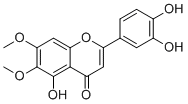Home
Products
Cirsiliol



| Product Name | Cirsiliol |
| Price: | $336 / 5mg |
| Catalog No.: | CN04727 |
| CAS No.: | 34334-69-5 |
| Molecular Formula: | C17H14O7 |
| Molecular Weight: | 330.29 g/mol |
| Purity: | >=98% |
| Type of Compound: | Flavonoids |
| Physical Desc.: | Powder |
| Source: | The aerial parts of Phyla nodiflora. |
| Solvent: | Chloroform, Dichloromethane, Ethyl Acetate, DMSO, Acetone, etc. |
| SMILES: | COc1cc2oc(cc(=O)c2c(c1OC)O)c1ccc(c(c1)O)O |
| Contact us | |
|---|---|
| First Name: | |
| Last Name: | |
| E-mail: | |
| Question: | |
| Description | Cirsiliol is a potent and selective 5-lipoxygenase inhibitor and a competitive low affinity benzodiazepine receptor ligand. |
| Target | Target: 5-lipoxygenase[1] |
| In Vitro | In concentrations from 0.01 to 300 μM, cirsiliol causes concentration-dependent relaxation of rat isolated ileum. Cirsiliol may inhibit Ca2+ influx but stimulates Ca2+ release from intracellular stores[1]. Treatment with rhamnetin or cirsiliol reduces the proliferation of NSCLC cells through the suppression of radiation-induced Notch-1 expression[2]. |
| In Vivo | In xenograft mouse model, tumor volume is significantly reduced by combinational treatment with irradiation and rhamnetin or cirsiliol compared with irradiation alone[2]. |
| Cell Assay | NSCLC, NCI-H1299, NCI-H460, WI-26 VA4 and MRC-5 cell lines are exposed to a single dose of γ-rays. Cells are then treated with rhamnetin and cirsiliol (5, 10, 15, 20, 25 μM) dissolved in DMSO for 4 h[2]. |
| Animal Admin | Mice[1] BALB/c athymic nude mice are injected with 2×106 NCI-H1299 cells. When the tumor has acquired a minimal volume of 200 mm3, DMSO or Cirsiliol (200 μg/kg body weight) is administered intraperitoneally every day for 25 days. The animals are also irradiated with 10 Gy once a week for 3 weeks. On day 25, the tumors are excised and subjected to further analyses[1]. |
| Density | 1.5±0.1 g/cm3 |
| Boiling Point | 616.1±55.0 °C at 760 mmHg |
| Flash Point | 230.8±25.0 °C |
| Exact Mass | 330.073944 |
| PSA | 109.36000 |
| LogP | 2.27 |
| Vapour Pressure | 0.0±1.8 mmHg at 25°C |
| Storage condition | 2-8℃ |